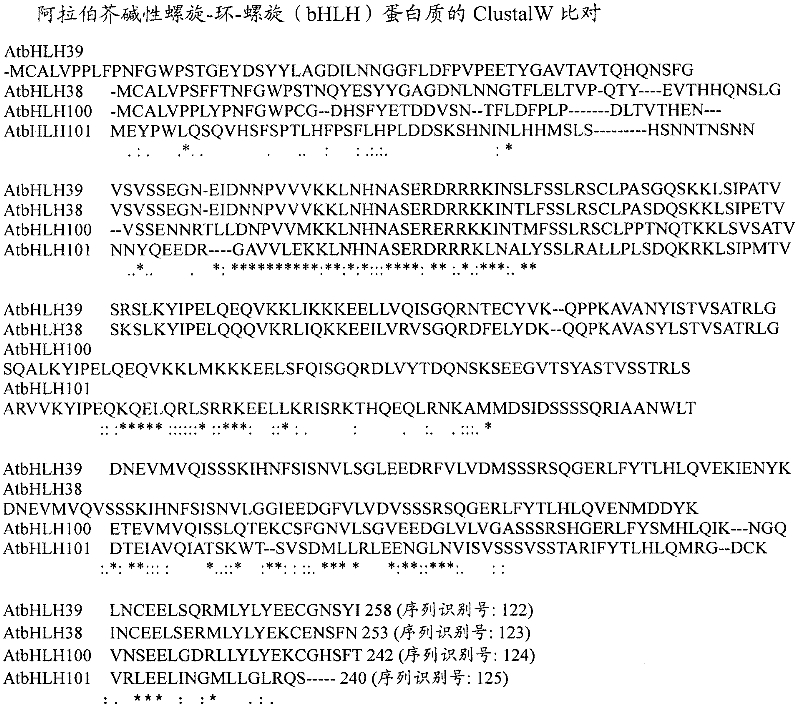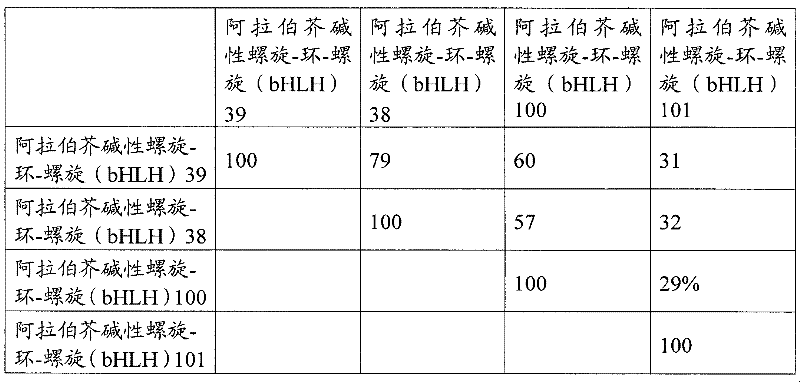Expression of transcription regulators that provide heat tolerance
A tolerant, transgenic plant technology, applied in genetic engineering, plant genetic improvement, angiosperms/flowering plants, etc., can solve problems such as iron deficiency tolerance
- Summary
- Abstract
- Description
- Claims
- Application Information
AI Technical Summary
Problems solved by technology
Method used
Image
Examples
Embodiment 1
[0107] Example 1: Identification of homologous genes
[0108] Basic helix-loop-helix (bHLH) 39 and Basic local alignment search for its Arabidopsis homologues basic helix-loop-helix (bHLH)38, basic helix-loop-helix (bHLH)100, and basic helix-loop-helix (bHLH)101 Tool (Blast) search. Genome sequence databases are for varieties for which the complete sequence is known, such as rice and sorghum. To confirm that the sequence does indeed belong to the ortholog of the target sequence, a basic local alignment search tool (blast) search of all putative homologues in the complete Arabidopsis protein database needs to be performed thereafter , and any sequence that hits Arabidopsis first and is not one of the four target sequences will be filtered out without any further analysis. To minimize the redundancy that exists between multiple hits, all EST sequence hits were assembled using the cap3 assembly program to ensure that they had a minimum of 40 nucleotides in length. 90% ident...
Embodiment 2
[0113] Embodiment 2: the construction of carrier
[0114] The binary vector pBI121 is optimized for the transformation of Arabidopsis and different crops. The GUS gene present in pBI121 was deleted by digestion and religation of SmalI and EcolCR1, thereby obtaining the vector pBI121ΔGUS. This vector is used to clone genes for overexpression. The 1.1 Kb portion of the C-terminus of the GUS gene was isolated from pBI121 as an EcoR V-Sac I fragment (position 6613-7715 on pBI121) and the Sma I on pBI121ΔGUS and clone it at the Sac I site to obtain pBI121tGUS (the N-terminal portion of the GUS gene has been deleted). The vector is used to make a hairpin construct for gene deregulation, wherein the construct is constructed using a part of the GUS sequence as the loop or spacer.
[0115] The NPTII gene and its derivatives present in the vector pBI121 contain a site-directed mutagenesis (a G to T mutagenesis at position 3383 of pBI121, amino acid substitution E182D). The above-m...
Embodiment 3
[0118] Example 3: Overexpression constructs of basic helix-loop-helix (bHLH) subgroup 1b body building
[0119] Construct 35S - Arabidopsis basic helix-loop-helix (bHLH) 39:
[0120] The Arabidopsis basic helix-loop-helix (bHLH) 39 (At3g56980) coding sequence was amplified from Arabidopsis by reverse transcription-polymerase chain reaction (RT-PCR), wherein Forward primer BHLH039FW-XbaI and reverse primer BHLH039RV-BamH I were used in the addition. The polymerase chain reaction (PCR) product (0.8Kb) was cloned at the Xba I and BamH I sites of the binary vectors pBI300ΔGUS and pBI800ΔGUS to establish the construct 35S-Arabic Mustard basic helix-loop-helix (bHLH)39-pBI300 and 35S-Arabidopsis basic helix-loop-helix (bHLH)39-pBI800.
[0121] Construct 35S - Arabidopsis basic helix-loop-helix (bHLH) 101:
[0122] The Arabidopsis basic helix-loop-helix (bHLH) 101 (At5g04150) coding sequence was amplified from Arabidopsis by reverse transcription-polymerase chain reaction (RT-...
PUM
 Login to View More
Login to View More Abstract
Description
Claims
Application Information
 Login to View More
Login to View More - R&D
- Intellectual Property
- Life Sciences
- Materials
- Tech Scout
- Unparalleled Data Quality
- Higher Quality Content
- 60% Fewer Hallucinations
Browse by: Latest US Patents, China's latest patents, Technical Efficacy Thesaurus, Application Domain, Technology Topic, Popular Technical Reports.
© 2025 PatSnap. All rights reserved.Legal|Privacy policy|Modern Slavery Act Transparency Statement|Sitemap|About US| Contact US: help@patsnap.com



